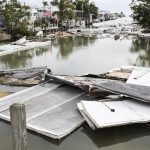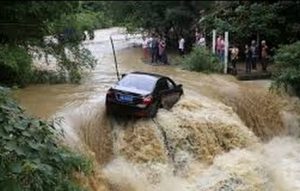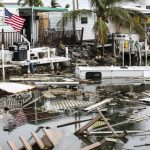Safety Tips for Driving Through and Avoiding Flash Floods
Safety Tips for Driving Through and Avoiding Flash Floods
By: H. Davis

A natural disaster can happen without warning, striking at anytime, anywhere. They can cause thousands of dollars in damage, especially when it comes to fast-moving water — also known as floods. That’s because most cars can be swept away in just 20 inches of water. In deep water, however, cars can sink, and lives can be lost as a result. While most motorists understand the risk of driving through water, some might feel like invincible drivers. Although places like Louisiana are well-known for extreme flooding, the truth is, flooding happens in every state. Massachusetts, Minnesota, Texas, and Washington DC, for example, all experienced floods in 2017. Other states like Arizona, and California typically flood when they are hit by unexpected storms that can clog drains.
That said, if you ever heard the saying life has a way of throwing curveballs at you unexpectedly, then you know this is especially true when it comes to natural disasters. The curveballs described, however, aren’t just physical. They’re emotional, psychological, and financial. That’s why it’s important for residents to find ways to address these issues ahead of time, and always plan for events for like earthquakes, hurricanes, and twisters.
Simply put: Flooding is a hazard that goes far beyond communities. In fact, it’s a nationwide concern. That being said, here are some ways drivers can stay safe on the road and out of harm’s way. Be sure to let these tips sink before it’s too late.
Practicing Safe Driving
 Be Sure Not to Tailgate: Do you remember the three-second distance rule you were taught while learning how to drive? If the answer is “no,” don’t worry — you’re not alone. That’s because hardly any drivers on the road today actually follow the rule they once learned to pass their driving test. Just because others ignore it, however, doesn’t mean you should. During rainy days, for instance, cars need more time for their brakes to work properly while driving on slick or wet roads. This means that if drivers are slamming on the brakes to come to a complete stop, the driver will likely hydroplane and hit the next vehicle or person in front of it.
Be Sure Not to Tailgate: Do you remember the three-second distance rule you were taught while learning how to drive? If the answer is “no,” don’t worry — you’re not alone. That’s because hardly any drivers on the road today actually follow the rule they once learned to pass their driving test. Just because others ignore it, however, doesn’t mean you should. During rainy days, for instance, cars need more time for their brakes to work properly while driving on slick or wet roads. This means that if drivers are slamming on the brakes to come to a complete stop, the driver will likely hydroplane and hit the next vehicle or person in front of it.
Depending on the size, weight, and speed of the vehicle, it can take less than an inch of water to send a car into hydroplane mode. So, the next time you pull up to a traffic light, be sure to give the car in front of you some extra room. Remember, the closer the driver is to the intersection or other vehicles, the more likely they are to experience an accident.
Watch Where You Pull Over: Most people who live in a colder climate state can handle a little rain or snow. Even though these conditions aren’t ideal, residents learn to live with them and carry on with their lives. Nevertheless, there are always certain conditions drivers should never operate a vehicle in — no matter how good of a driver they are — and flash flooding is one of them.
Who could forget when Hurricane Sandy hit the East Coast in 2012? Or when Hurricane Harvey hit Texas in 2017? Both storms ripped through cities and ruined countless homes in the process. Aside from damaging hundreds of homes, the storms also killed a combined of 119 residents — 37 in 2012 and 82 in 2017. It also highlighted why residents should never drive in storms and why they should also never pull off the road.
While heavy rain might impair visibility and make it difficult for drivers to see, pulling over on a busy road or highway is actually more dangerous. For one, other vehicles might run into the back of you, which could cause you to get trapped or injured. Another reason drivers shouldn’t pull over on a busy road has to deal with the rainwater. In other words, if your vehicle is parked near a drain or the curb, then water can start to build up under the vehicle, causing the engine to break. If that happens, the chance of moving your vehicle without assistance is slim to none, which leave you in a vulnerable state. So, what can you do instead? Just continue driving until you spot a safe location to pull over.
Eyes on the Road (Not on the Phone): At first, it might be tempting to grab a phone and start filming the experience, but the truth is, it’s not worth it. According to the National Highway Traffic Safety Administration, distracted driving is becoming the leading cause of accidents on the road, which means motorists must be on high alert during storm season. This means looking out for other drivers, watching for downed power lines, and avoiding areas with lots of water. These are things that can cause you to get stuck and could put your life in danger.
So instead of checking weather updates and social media accounts while you’re driving, check them when you’re home and in a safe environment. If you absolutely must send a message, make a phone call, or check emails, be sure to pull over somewhere safe before doing so and to keep your hazard lights on. This will help other drivers see that you’re at a stationary position and therefore make it easier for them to make a good judgment.
What to do if you’re swept away by floods?
 For residents who live in flood-prone areas, there are often signs that a flood may be imminent. Despite the fact that most safety articles recommend people not to panic, it’s the first thing everyone does. Keep in mind that it only takes 6 inches of fast moving water to knock someone off their feet and cause a vehicle to lose control, so be alert and pay close attention to the direction of the water. That said, if your vehicle begins to flood while you’re in it, take your seatbelt off and roll down the window before electrical components start to fail. If the window doesn’t roll down, then let the vehicle fill with a water for a bit before trying to open the door. Whatever you do, don’t wait for the car to sink before trying to plan your escape; do this right away.
For residents who live in flood-prone areas, there are often signs that a flood may be imminent. Despite the fact that most safety articles recommend people not to panic, it’s the first thing everyone does. Keep in mind that it only takes 6 inches of fast moving water to knock someone off their feet and cause a vehicle to lose control, so be alert and pay close attention to the direction of the water. That said, if your vehicle begins to flood while you’re in it, take your seatbelt off and roll down the window before electrical components start to fail. If the window doesn’t roll down, then let the vehicle fill with a water for a bit before trying to open the door. Whatever you do, don’t wait for the car to sink before trying to plan your escape; do this right away.
After you’ve made it out of the vehicle, the next thing you’ll want to do is find high ground. That’s because swimming in cold, fast-moving water can really drain what energy you have left and cause the body into go in shock. If that happens, then you could accidentally swallow contaminated water that contains harmful bacteria and viruses in it. This will likely only happen in an extreme case, however.
While life after the floods can be just as dangerous as the event itself, in the end, being a safe driver should always be your number one priority. This will allow drivers the opportunity to grow, and live productive lives by practicing safe driving. Just make sure you have a full tank of gas and use extra caution in intersections, bridges, and overpasses. You should also keep an emergency kit in the trunk of your car as well.
–––––––––––––––––––––
Thanks for the read! Did I miss anything important? What are some other safety tips drivers should be aware of when it comes to flash floods? Please leave a comment below.
H. Davis appreciates exploring the outdoors and reading up on preparedness topics. If you can’t find him online, you might be able to catch him cheering on the Dodgers. Follow him on Twitter @Davis241. Thanks!
Avoiding Driving Flash Floods floods safety Safety Tips tips

